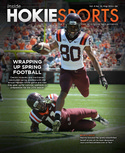The compliance corner answers questions concerning the governance of intercollegiate athletics and its impact on our athletics department. Have a question? Please send it to inside@hokiesports.com and we’ll answer it in upcoming issues.
Now, here are a couple of questions that we’ve received from Tech alums and fans over the past few months, with responses from Tim Parker, Associate AD for Compliance & Governance:
Q: How in the world does Kentucky not get banned from the NCAA tournament with all their players usually leaving after a year? Last year, UConn was banned – and not because any of their players went to the NBA. I just don’t understand it. Help me, please. Thanks, Camden in Christiansburg, Va.
TP: “Sure – and good question because I don’t think many people understand the Academic Progress Rate (APR), which is the NCAA metric used to determine if a team’s players are in good academic standing.
“A team’s score gets docked when a scholarship player leaves school in poor academic standing at the end of a semester, or if a player isn’t academically eligible at the end of a semester.
“A perfect score is 1000. A score of 925 was determined to be roughly equivalent to a 50 percent graduation rate. In the year that UConn got punished, the benchmark was 900, and UConn got an 889. APR scores cover a rolling four-year window, so last year’s UConn team was punished for the program’s academic performance between 2007-11. UConn also had fair warning – it was penalized with a scholarship reduction before the 2011-12 season.
“Regarding Kentucky, the players don’t necessarily have to graduate to earn the APR points. They just need to pass their classes. Kentucky hits the APR benchmark because its players are in good academic standing when they leave for the NBA.”
Q: The Hokie Club has been out attending events as part of the Orange & Maroon Tour, which occurs each spring. Could a student-athlete attend an event as part of this tour, or is this an NCAA violation? Thanks, Heather in Blacksburg.
TP: “Yes, a student-athlete could attend such a function, receive a meal, and even be provided actual and necessary expenses associated with the event (transportation, for instance).
“Virginia Tech has used football student-athletes in such roles in the past, most notably, with the kickoff dinners each August (Richmond and Roanoke). However, the Hokie Club has not used student-athletes on the Orange & Maroon Tour, and the simple reason is that nearly all of these functions occur during the week, when student-athletes are in class and engaging in practice.”
Q: There just seems to be way too much transferring in college basketball – and I would say that even before the news hit about Trevor Thompson leaving. Has the NCAA looked at this issue, and is anything being discussed? Thanks, Rachel in Blacksburg.
TP: “I think most people feel that there is too much transferring in college basketball – more than 400 players transferred last season – and an NCAA transfer issue subcommittee has been studying this issue.
“A little background: In many sports, a transferring student-athlete may compete immediately at his/her new school by utilizing what is known as the “One-Time Transfer Exception.” This exception, however, does not apply to participants in the sports of basketball, football, baseball and ice hockey. For these individuals, NCAA regulations mandate a one-academic-year residence requirement (commonly known as “sitting out”). As a result, a transferring student-athlete in one of these sports must apply for a waiver to compete right away.
“What has troubled coaches and administrators is both the high percentage of waivers approved (why even have the rule if half the applicants receive a waiver?), and the perceived inconsistency in the waiver process. Add to these concerns the difficulty in confirming that the reasons for transfer put forward in each appeal are real and legitimate, and you have widespread support for change.
“In January, the subcommittee proposed two recommendations – one affecting undergraduate transfers and one affecting graduate transfers. In both cases, there would be no possibility of immediate eligibility. Since that time, the graduate proposal has been taken off the table, while the undergraduate proposal appears headed for adoption. The NCAA Board of Directors will make the final call, and if adopted, the directive will not take effect until August 1, 2015.”




